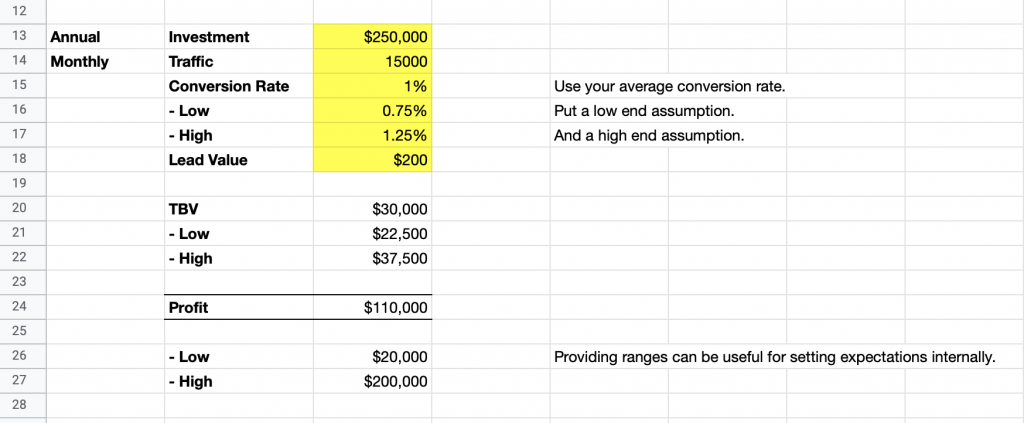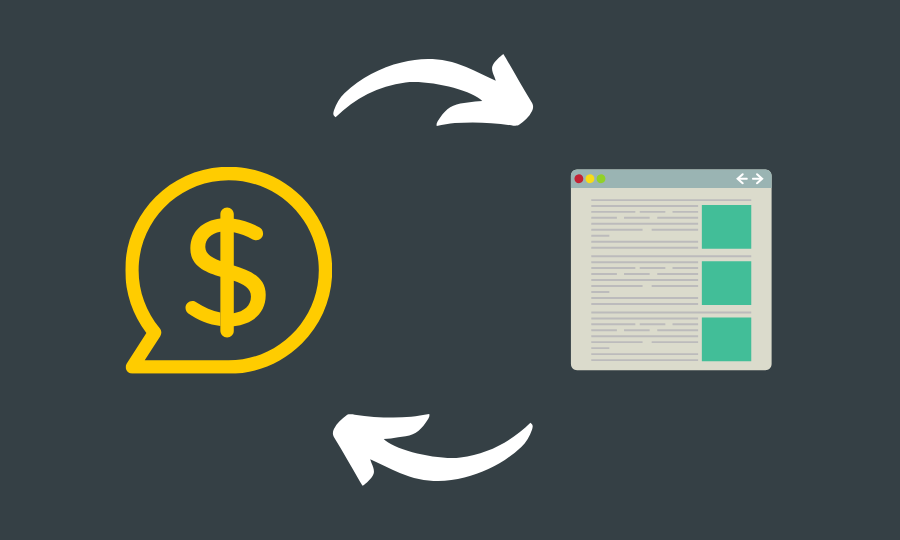In this post we establish what your content ROI is, how to calculate it and explain it to others.
What is Content ROI?
What the return on investment of content boils down to is this: does it deliver the business outcome that you require? Pretty simple.
How do you define those outcomes? That’s the more tricky part. But it typically comes down to a few buckets, awareness, interest, desire and action.
Content should take a potential customer from one stage to another. It should leave an impact. And if it does, it has done its job.
The easiest way to anchor this is to use this Content ROI template to guide your efforts. Duplicate the Google Presentation. We’ve included a preview of the PDF below.
I am using content to persuade [describe customer] who is presently [their present state] to do [your goal].
For example, I am writing this piece of content to persuade you (the reader) who has likely googled something along the lines of ‘the ROI of content’, to improve your content through a better understanding of ROI and to consider how Nudge can help you do that.
How to calculate Content Marketing ROI?
So, that’s our template for the strategic reasons on how content can drive ROI. Now if you want the more quantitative view, we have created this snazzy Content ROI calculator.

It is very simple, it presumes a volume of people, a conversion rate, and an assumed value of that happening.
Now if you are starting out, maybe you want to put ranges on this. For example, if you sign up to our newsletter, you might spend $10k, you might spend $20k. Once you have enough volume you can fine-tune the amount. But feel free to use the ranges.
This is also useful for managing stakeholders and setting expectations. Providing ranges indicates there are some unknowns but provides directionality on where it can land.
However, the ultimate test is
The sitting at the bar test. When you catch up with a friend, can you explain to them, what your content does to deliver business results?
If you can hit that standard, then you have done a good job. That doesn’t mean it is successful but you have a clear understanding of how it drives business results.
What software can you use to measure ROI?
You want content analytics that can measure people on content, and link that up with attribution, to understand if users take your desired action. You also want to be able to visualize this; to have somewhere to show you the data – in order to optimize the content, report on it, and share it with your team.
Fortunately, this is what Nudge does. 🙂 We provide all of this in one place, so you can spend less time worrying about the data and more time improving the content.
Other popular tools include Google Analytics, Adobe, often paired with Tableau, or Domo. Or to pipe this data into Google Sheets.
What research supports the ROI of content?
You’re in luck, we continuously compile the latest research and data in our State of Content post.
- Research shows that consumers spend more time on content than watching a TV ad, they convert at 1-3% and actually prefer content.
- Other research states that consumer awareness of a brand increased 69% after engaging with branded content. Purchase intent increased by 51%.
When you stop and think about it, it makes sense; content puts the consumer first. If the content is good enough to warrant my attention. Then I’m likely to take the next step.
In fact, here at Nudge, we found by going through our own data, that whether it’s brand lift, awareness, purchase intent, consideration or actual sales, using attention as your scorecard is the best identifier of value. Because attention will create all of those outcomes. It tells you the content is doing its job – and you yours. In other words, the higher the attention, the likelier it is that your ROI will increase.
But the important thing is, you want your content to make an impact. Whether that’s post-consumption conversions and purchase intent, or that every user is simply having a good experience.
Failing that, the best proxy is exceeding or matching your own or industry-wide benchmarks (i.e. ensuring that the content is pulling its weight).
As a quick side note, our own Gustaf has a great series on the emotional impact of content.
What about for B2B content?
10 years ago a friend of mine started a B2B Marketing Agency, at the time a very niche thing. However, today, not so much. Now all businesses need to communicate, to position themselves, to embrace thought leadership and educate their prospects. Content has to fit into their market’s life and workstyle. Because if yours doesn’t, your competitors will.
A question we often get asked is, what are the nuances of content ROI for B2B?
There is a bunch, the overarching principles ring true. However, there are some differences:
- Prospects can be more motivated to learn about, demonstrate knowledge and expertise in solving a problem.
- The outputs from your content can be tangible and make a difference in their business.
- Word of mouth is even stronger.
- One deal can pay the whole marketing budget.
- The scale is a lot smaller. You don’t want 1m views, you want 5,000 that shift the dial.
- Increased opportunity for evergreen content.
The key pillars remain though, you want to use content, to change your audience’s perception from X to Y.
What are some of the best practices?
Our Oppenheimer Case Study is a great real-life example in using data to driven content marketing roi.
1) They had an understanding of their business ROI.
2) They built a methodology to measure the impact against this ROI.
3) They then fed the data back into their data creation and distribution process.
4) This led to their best ever growth.
Treat this as your content checklist, if you’ve got this, then stack up all of your efforts and investments against it. You will be far ahead of the pack and far ahead of your competitors.
A practical guide to ROI on content.
Jess on our team did a great post, looking at the levers that drive ROI. That is when you have the above framework, what can you tactically change, to improve our business results.
It comes down to four pillars:
- People, ensuring you get enough people to see the content.
- Good content, ensuring your content performs well (easy to read, consume, is useful).
- Consumption, are people consuming enough of your content? Or are they skimming it and leaving.
- Good distribution, if you’re buying clicks or promoting in the wrong places. You won’t get any impact.
When you have a specific piece (or pieces) of content, these are your four levers to go and improve.
As a side note, again, this is where benchmarks are helpful, to benchmark yourself on each of these components. To see where you fall.
This is part of our Guide to Content Marketing Analytics.

|
|---|
 Skip to content
Skip to content



